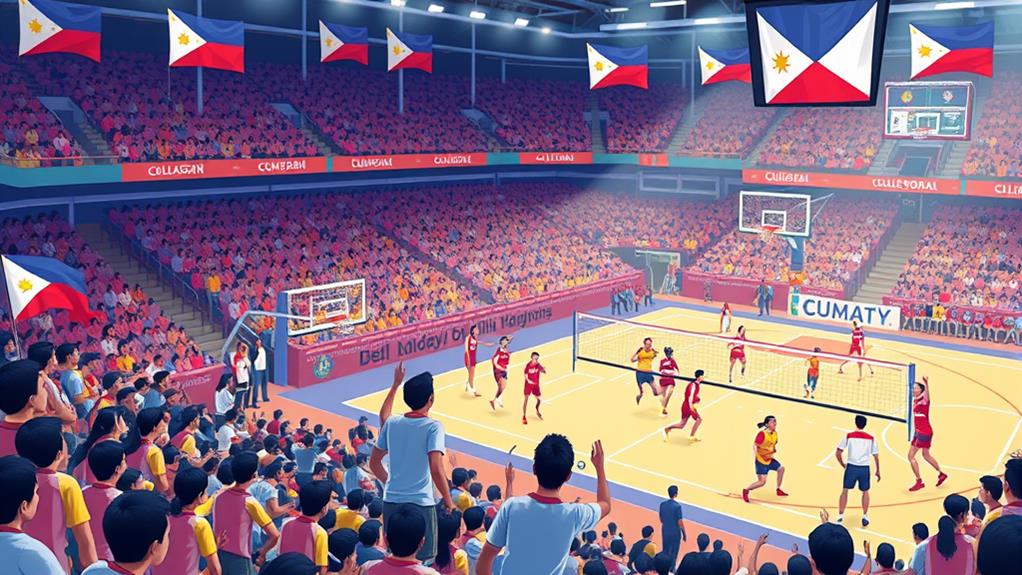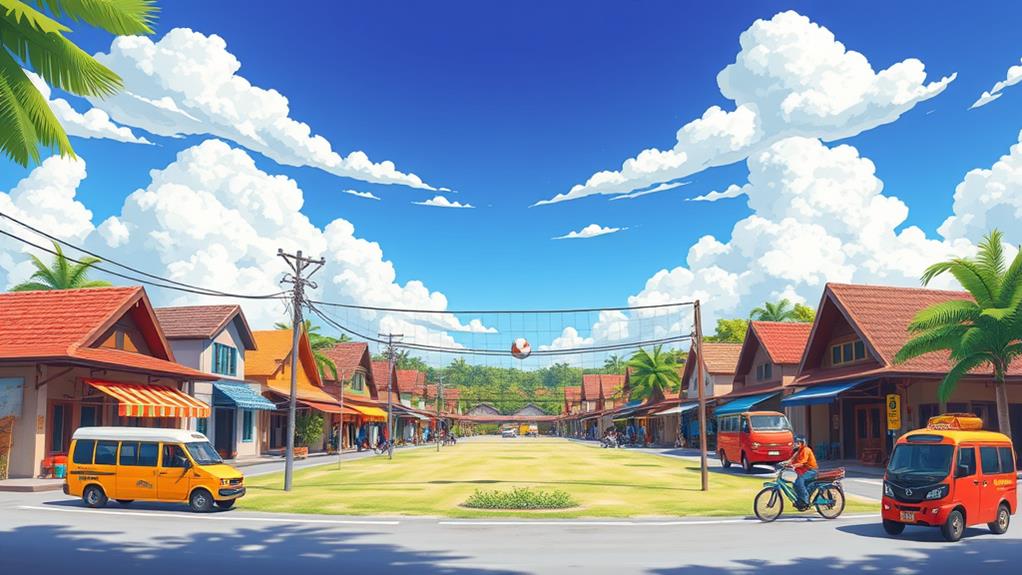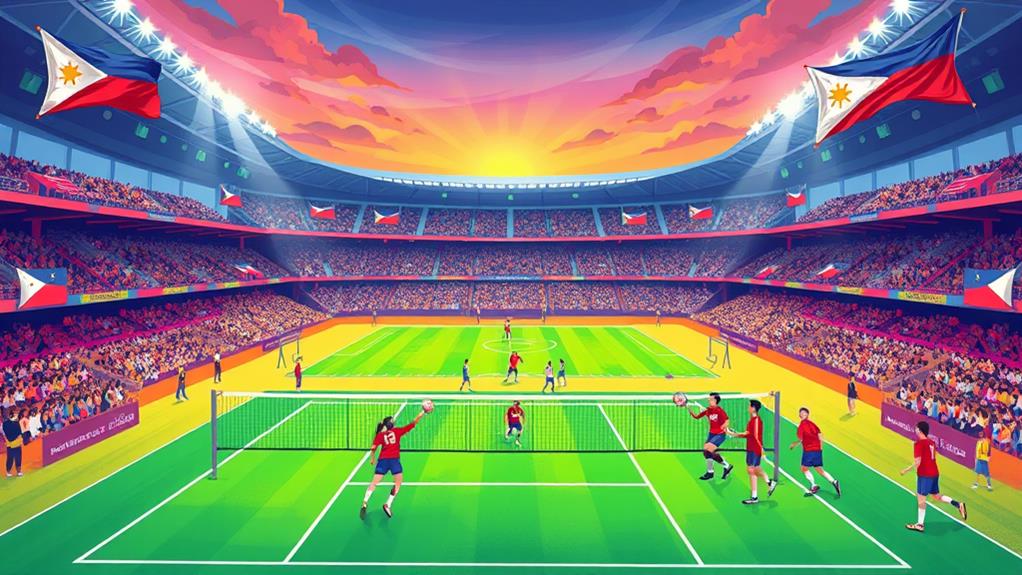Other popular sports in the Philippines have gained significant traction in recent years.
Volleyball has become a leading sport, especially among women. The sport has evolved with prominent players and collegiate leagues promoting teamwork and physical fitness.
Football’s popularity surged after the women’s team qualified for the FIFA Women’s World Cup 2023. This achievement ignited national pride and interest in the sport.
Traditional Filipino sports like Arnis, Dumog, and Sipa hold cultural value and foster community bonding.
These sports have been part of the country’s heritage and continue to be played and enjoyed by many Filipinos.
Volleyball’s Rise to Popularity
Volleyball’s Rise to Popularity in the Philippines
Volleyball’s popularity in the Philippines began in 1910 and has since evolved into one of the country’s most popular sports, particularly among women.
This growing interest in volleyball parallels the increasing appreciation for cultural activities, such as traditional Philippine folk dances, which also foster teamwork and community engagement.
The Philippine National Volleyball Federation oversees the sport, organizing major events like the University Athletic Association of the Philippines (UAAP) and National Collegiate Athletic Association (NCAA) volleyball tournaments.
These tournaments draw large crowds and viewership.
The women’s team has significantly contributed to the sport’s growing popularity, especially after their qualification for the 2023 FIVB Volleyball World Championship.
Household names like Alyssa Valdez and Jaja Santiago have contributed to the sport’s visibility and popularity through their performances and social media presence.
With a growing number of recreational leagues and grassroots programs, volleyball is increasingly seen as a means to promote physical fitness and teamwork among the youth in the country.
Volleyball has become an integral part of the country’s sporting landscape.
Football’s Growing Fan Base
Football’s popularity is surging in the Philippines, with its fan base growing rapidly across the country. This significant shift in interest can be attributed to the national women’s team’s historic qualification for the FIFA Women’s World Cup in 2023, which sparked nationwide enthusiasm for the sport.
Football is fostering a sense of community among fans and players alike, similar to cultural events like the Kadayawan Festival, which celebrates unity and cultural heritage.
Youth engagement programs and grassroots initiatives are taking root, ensuring football’s long-term presence in the Philippines’ sports scene.
Rise of Football Fans
Rise of Football Fans in the Philippines
The Philippines is experiencing a rapid growth in football popularity, driven by a combination of local and international factors. One significant contributor to this growth is the historic achievement of the national women’s team qualifying for the FIFA Women’s World Cup 2023, sparking interest and pride among Filipinos.
National Team’s Success
The women’s team’s achievement has encouraged more people to follow the sport. This success has instilled a sense of national pride, motivating fans to support the team and increasing interest in the sport.
Philippine Football League (PFL)
Established in 2017, the PFL has created a more structured and professional landscape, drawing in local fans and increasing participation at the grassroots level.
This has led to a more organized and competitive league, which has attracted more fans and encouraged youth engagement.
International Influence
The global popularity of football, combined with the influence of international leagues and tournaments, has contributed to the growing fan base in the Philippines.
International competitions, such as the English Premier League and the UEFA Champions League, have increased football’s exposure and appeal to Filipino audiences.
Youth Engagement and Social Media
Grassroots programs and leagues have encouraged youth engagement, while social media and digital platforms have expanded football’s reach, enabling fans to connect with international teams and access live match coverage.
This has made it easier for fans to follow their favorite teams and players, increasing their enthusiasm for the sport.
These factors have combined to create a vibrant football community in the Philippines, with a rapidly expanding fan base that’s eager to support local clubs and the national team.
Growing Popularity Nationwide
Football’s popularity has surged nationwide in the Philippines, driven by a significant increase in fan engagement and participation.
The establishment of the Philippine Football League (PFL) in 2017 has fostered local talent and competition, contributing to this growth. Additionally, the Philippine women’s national football team’s historic qualification for the FIFA Women’s World Cup 2023 has boosted interest and support for the sport nationwide.
Several factors have contributed to this surge in popularity. The PFL has led to local talent development and increased competition.
Grassroots programs have increased youth participation, leading to a growing fan base. Moreover, the women’s national team’s historic World Cup qualification has boosted national interest.
The growing fan base is reflected in increasing attendance at local matches and the rise of football academies, which aim to develop the skills of aspiring young athletes.
Media coverage and sponsorship deals have also improved, with matches being broadcasted on various platforms, further engaging fans and elevating the profile of football in the Philippines.
As a result, football fever is on the rise across the country.
Youth Engagement Programs
Youth engagement programs have been instrumental in cultivating a strong foundation for football in the Philippines. These initiatives have been crucial in promoting the sport among young people, fostering a growing fan base.
Programs like the “Grassroots Football Program” introduce football to children in schools and communities, fostering a love for the game from an early age. This contributes to the growth of local talent and increased participation in competitive leagues and tournaments.
The Department of Education has integrated football into its physical education curriculum, helping to cultivate skills and passion for the sport among students nationwide. This integration has played a significant role in promoting football among young people.
The Philippine women’s national football team, known as the Malditas, qualified for the FIFA Women’s World Cup 2023, significantly inspiring youth participation and interest in football. This achievement has motivated young people to engage in the sport.
Various football leagues and tournaments for youth, such as the Philippine Football Federation (PFF) Under-13 and Under-15 leagues, provide competitive opportunities for young players to develop their abilities and gain experience. These leagues have helped to increase youth participation in football.
The Philippine Football League (PFL) provides a platform for local talent to shine, increasing the sport’s visibility and appeal to young fans. This platform has contributed to the growth of football’s popularity among young people.
Traditional Filipino Sports Disciplines
Traditional Filipino Sports Disciplines
The Philippines boasts a rich cultural heritage, encompassing a diverse range of traditional sports disciplines that have been an integral part of the country’s identity for centuries.
Martial Arts
Arnis, recognized as the national martial art since 2009, is a traditional martial art that focuses on weapon-based combat, promoting Filipino heritage.
Another traditional wrestling form, Dumog, emphasizes control and technique, utilizing various methods to pull and pin opponents in a display of skill.
Festive Games
In festive celebrations, participants engage in Palo-sebo, a climbing game where they attempt to scale a greasy bamboo pole to retrieve a reward bag at the top.
Sikaran, originating from Rizal, is a unique martial arts discipline that utilizes kicking techniques, specifically targeting the opponent’s head with the Biakid kick.
Traditional Games
Sipa, a traditional game similar to sepak takraw, was played long before Spanish colonization. It involves kicking a metal washer or ball, showcasing agility and speed.
These sports disciplines not only reflect the country’s history and culture but also highlight the Filipino people’s athleticism and competitive spirit.
Notable Individual Sports Achievements
The Philippines has a rich sports landscape marked by notable individual achievements.
In boxing, Filipino champions like Manny Pacquiao and Nonito Donaire have symbolized bravery and resilience, bringing pride to the nation with their numerous championship titles.
Figure skating has also seen significant milestones, with athletes like Michael Christian Martinez competing in the Winter Olympics and reflecting the rich cultural heritage of the Philippines.
Rugby league has recently emerged as a new sport, further diversifying the country’s sports culture.
Traditional practices like tattooing hold deep cultural significance, reminding us of the country’s rich history.
These achievements haven’t only brought pride to the nation but have also inspired a new generation of athletes to strive for excellence.
Boxing Champions’ Legacy
The Philippines has a rich history of producing world-class boxing champions, leaving a lasting impact on the sport.
The country has produced over 40 boxing world champions, with many more aspiring to follow in their footsteps. This impressive record is a testament to the nation’s boxing prowess.
The Amateur Boxing Association of the Philippines plays a crucial role in governing amateur boxing and aims to secure the country’s first Olympic gold medal in the sport. This goal is a driving force behind the development of young Filipino boxers.
Filipino boxers have made their mark on the international stage, sanctioned by the International Boxing Association (AIBA). This recognition has provided opportunities for Filipino boxers to compete against the best in the world.
The legacy of Filipino boxing champions has significantly contributed to the sport’s popularity in the country, fostering national pride and inspiring a new generation of athletes.
The achievements of champions like Manny Pacquiao and Nonito Donaire have cemented the Philippines’ reputation as a powerhouse in boxing, motivating others to strive for excellence.
Figure Skating Milestones
The Philippines has achieved significant milestones in figure skating, a winter sport.
One notable achievement is Michael Christian Martinez becoming the first Southeast Asian figure skater to qualify for the Winter Olympics, competing in the 2014 Sochi Games.
The Philippine Championship serves as the national competitive event for figure skating, showcasing the talent of local skaters and promoting the sport within the country.
Despite limited ice skating rinks in the Philippines, primarily located in Metro Manila shopping malls, figure skating has grown as a niche sport.
The opening of the first Olympic-sized ice rink at SM Mall of Asia has provided a venue for aspiring figure skaters to train and compete.
Filipino figure skaters have participated in various international competitions, with athletes like Martinez inspiring a new generation of skaters in the country.
Rugby League Emergence
Rugby League Emergence in the Philippines
By 2012, rugby league had finally arrived in the Philippines, marking the emergence of a new team sport in the country.
The Philippine National Rugby League (PNRL) oversees the development and competitions of rugby league in the country.
International Participation
The national team, the Philippine Tamaraws, has been participating in international tournaments, showcasing local talent on the global stage. This exposure has helped to raise the profile of rugby league in the Philippines.
Grassroots Development
Grassroots initiatives and local leagues have contributed to the sport’s growth in schools and communities. These efforts have helped to increase participation and develop local talent.
Support from the Philippine Rugby Football Union
The Philippine Rugby Football Union (PRFU) supports the development of rugby league alongside rugby union, promoting both codes of the sport within the country. This support has been instrumental in the growth of rugby league in the Philippines.
New Opportunities for Filipino Athletes
Rugby league has been making strides in sport development, providing new opportunities for Filipino athletes to excel. The sport has opened doors for athletes to compete at the national and international levels.
Dedication and Passion
The sport’s emergence has been driven by the dedication and passion of its players, coaches, and fans. This enthusiasm has helped to create a strong foundation for the sport in the Philippines.
Team Sports and Domestic Leagues

Domestic Leagues Drive Team Sports in the Philippines
Team sports are a vital part of the Philippines’ sports landscape, and domestic leagues play a crucial role in fostering a strong following and nurturing local talent. Volleyball, Football, and Basketball are the most popular team sports in the country.
League and Federation Overview
| Sport | League/Federation | Notable Achievements |
|---|---|---|
| Volleyball | Philippine National Volleyball Federation | Collegiate competitions, national team tournaments |
| Football | Philippine Football League | National women’s team qualified for FIFA Women’s World Cup 2023 |
| Basketball | Philippine Basketball Association (PBA) | Asia’s oldest professional league, Gilas Pilipinas men’s national team |
| Basketball | Gilas Pilipinas | Competed in Summer Olympics since 1936, hosted FIBA World Cup 2023 |
| Multi-Sport | Palarong Pambansa, Philippine National Games | Promotes grassroots participation, talent development for youth and amateur athletes |
Contribution to the Country’s Sporting Culture
These domestic competitions and leagues have contributed to the country’s rich sporting culture, providing opportunities for athletes to develop their skills and represent the Philippines on the international stage.
International Sports Participation Highlights
The Philippines has made significant strides in international sports participation.
The country has qualified for the FIFA World Cup and competed in the AFC Asian Cup through its national football team, the Azkals. Additionally, the women’s team made history by qualifying for the FIFA Women’s World Cup in 2023.
The Philippines has participated in the Asian Volleyball Championships and the FIVB Volleyball World Championship. Local clubs often represent the nation in these competitions.
Gilas Pilipinas, the Philippine men’s national basketball team, has competed in multiple FIBA World Cup tournaments. The team consistently participates in the Southeast Asian Games.
The Philippine Rugby Football Union governs a national team that competes in the Asia Rugby Championship and international tournaments like the Rugby World Cup.
These achievements demonstrate the Philippines’ growing presence in international sports, showcasing the country’s athletic talent and dedication to various sports disciplines.
Cultural Significance of Local Sports

Local sports hold significant cultural value in the Philippines. Volleyball, Football, and Arnis are prominent examples of sports that are deeply rooted in the country’s heritage.
Volleyball is a staple in local competitions, with leagues like the UAAP and NCAA drawing in massive crowds.
Football has historical significance, with the Azkals representing the country in international competitions.
Engaging in these sports promotes physical health, community, and social engagement. Traditional games like Sipa reflect the country’s rich cultural history and are often played during local festivals, fostering community bonding and social interaction.
The integration of sports like Sepak Takraw into school curriculums highlights their cultural significance and promotes physical activity among youth.
By embracing local sports, Filipinos celebrate their heritage. These sports are an integral part of the Philippines’ identity, shaping the nation’s character and values.
Prominent Filipino Athletes and Their Impact
Filipino athletes have made a significant impact in international competitions, inspiring a nation with their remarkable achievements.
The passion for sports in the Philippines is deeply rooted in cultural traditions. Sports have become an integral part of Filipino culture, just like folk music. This passion has led to the emergence of notable athletes who’ve brought pride to the Philippines.
Alyssa Valdez, a volleyball sensation, has significantly elevated the popularity of women’s volleyball in the country. Her exceptional skills and leadership in local and international tournaments have made her a household name.
Eugene Amano, a notable football player, has contributed to the growth of football in the Philippines. His experience playing in the NFL has inspired many young athletes to pursue the sport.
Carlos Yulo, a rising star in gymnastics, has made history by winning multiple medals in World Cup Series and Championships. His achievements have showcased the potential of Filipino athletes in international competitions.
Hidilyn Diaz, a weightlifter, made headlines as the first Filipino to win an Olympic gold medal in 2020. Her victory has inspired a new generation of athletes to strive for excellence in sports.
These athletes haven’t only excelled in their respective sports but have also inspired a nation, paving the way for future generations to follow in their footsteps.
Other Popular Sports in the Philippines

Volleyball’s Rich History
Volleyball has been a popular sport in the Philippines since 1910. In collegiate leagues like the UAAP and NCAA, community engagement and teamwork are at the forefront. These leagues have played a significant role in promoting volleyball in the country.
Celebrating Filipino Culture
Traditional Filipino culture is often celebrated through various forms of artistic expression, including traditional dances. These dances enhance community spirit and involvement, showcasing the country’s rich cultural heritage.
Football’s Rise to Prominence
Football is gaining traction in the Philippines, with the women’s national team making history by qualifying for the FIFA Women’s World Cup 2023. This achievement has increased interest and participation in the sport.
Sepak Takraw: A Unique Sport
Sepak Takraw, a traditional sport that combines elements of kicking and volleyball, is recognized for its skill and agility. The Philippines actively participates in international competitions governed by the International Sepaktakraw Federation.
Athletics: A Rich History
Athletics is ranked as the eighth most popular sport in the Philippines, with a rich history of notable athletes like Lydia de Vega contributing to the country’s track and field accomplishments on the international stage.
Promoting Community Engagement
The Philippine Sports Commission continues to support these sports, promoting community engagement and national team development.
As a result, these sports have become an integral part of the country’s sporting landscape, with many Filipinos participating in local and international competitions.
Conclusion
The Philippines has a diverse sports landscape with various disciplines gaining popularity. Volleyball has surged in popularity, with the Philippine Super Liga and the Premier Volleyball League drawing in large crowds and television audiences. Football, on the other hand, has a growing fan base, with the Philippines Football League and the national team competing in international tournaments.
Traditional sports like arnis, a martial art that is the national sport of the Philippines, and sepak takraw, a Southeast Asian game that combines elements of volleyball and soccer, still thrive in the country. Filipino athletes have also made their mark in international competitions, with boxer Manny Pacquiao and golfer Yuka Saso being notable examples. These athletes inspire the next generation, highlighting the importance of sports in Filipino society. Sports play a vital role in the country, promoting community and competition.